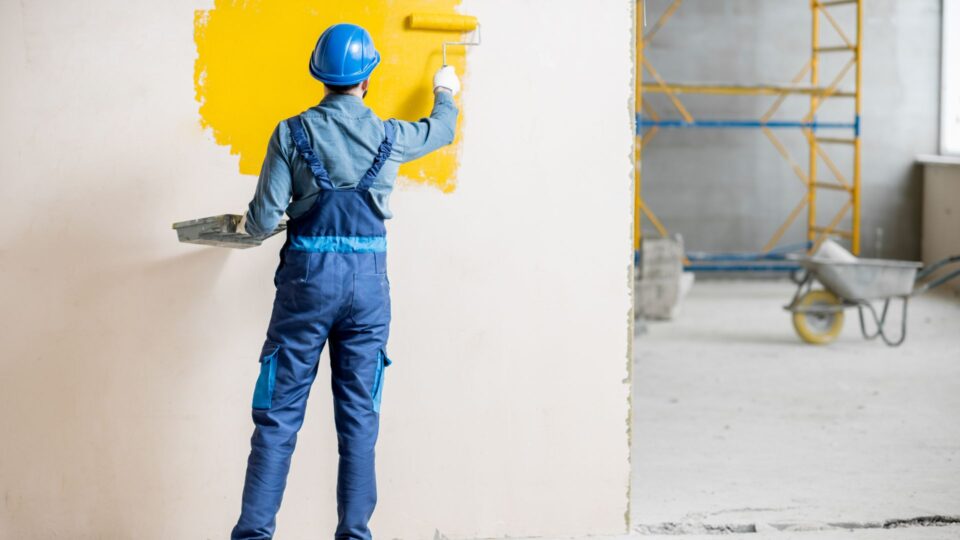Up to the 1950s, paint used on houses in Australia could contain up to 50% lead. In recent years, paint used in construction and decorating industries no longer contains lead but can still be dangerous when inhaled in large concentrations.
Are you doing enough to protect your employees from paint fumes?
Read on as we explore how to manage paint fumes and the dangers of paint fume inhalation.
The dangers of inhaling paint fumes
Here are some of the risks associated with inhaling paint fumes.
- Volatile Organic Compounds (VOCs) – When you inhale paint fumes, you inhale VOCs like benzene and toluene, which can be harmful in large concentrations. VOCs can make you experience dizziness, headaches, respiratory irritation, nausea, and central nervous system, kidney, and liver damage.
- Off-gassing – Solvent-based paints can emit hazardous chemicals during the drying process. Inhaling the fumes caused by off-gassing can lead to throat and lung irritation, respiratory damage, and nausea.
- Heavy metals – Some paints contain lead, cadmium, and chromium, toxic fumes that can be released into the air during painting. These fumes can cause neurological disorders, kidney damage, and respiratory problems.
- Prolonged exposure – One of the critical dangers associated with paint fumes is prolonged exposure. In manufacturing, industrial, decorating, and repair industries, extensive exposure to paint fumes can occur without health and safety compliance.
How long do paint fumes stay in your system?
Several factors influence how long paint fumes stay in your system. Here are some aspects to consider when exposed to paint fumes:
- Sensitivity – If you have pre-existing respiratory conditions, you could experience prolonged symptoms after inhaling paint fumes.
- Residual exposure – Even after the acute effects of paint fumes have subsided, you could experience low levels of VOCs.
- VOC elimination – Your metabolism and body size play a role in your ability to expel VOCs from your system.
- Short-term exposure – When you are only exposed to paint fumes for a limited time, you may experience dizziness and respiratory irritation. This should subside in a few hours or days.
Several factors determine how long paint fumes will stay in your system. It’s important to take pre-emptive action by using PPE to minimise the amount of paint fumes entering your body in the first instance.
What to do after inhaling paint fumes
Inhaling paint fumes can lead to serious health complications. By taking the following precautions, you can ensure the paint fumes’ impact is less severe:
- Move to a well-ventilated area – If you breathe in paint fumes, it is important to get to a ventilated area as quickly as possible and access fresh air. This will prevent further inhalation and help to dissipate the fumes from your respiratory system.
- Rest – Try to rest to combat the dizziness you experience when inhaling paint fumes. Breathe deeply and lie down to improve blood flow.
- Rinse your eyes, nose, and mouth – to prevent irritation, rinse your eyes, nose, and mouth. This will help reduce the amount of chemicals in your sensitive areas.
- Monitor your symptoms – You should avoid further exposure in the next few days, making a note of any severe or persistent symptoms which could indicate a health issue. Contact a medical professional immediately if dizziness, shallow breathing, or chest pain persists.
How to stop paint fumes
One of the best way to reduce exposure to paint fumes in a construction environment is to use extraction fans. Here are some of the best ventilation solutions for managing paint fumes.
Axial fans
Axial fans are lightweight and maneuverable, making them an excellent portable solution for your job site. They provide a horizontal airflow to stimulate air circulation and reduce paint fumes. Here are some of the different types of axial flow fans you can choose from:

Wall exhaust fans
Wall exhaust fans are highly discreet. They are permanent fixtures ideal for painting workshops or industrial settings. They are typically installed on a side wall to provide ventilation and extraction, providing a steady air exchange rate.

Extraction roof fans
Here are some different types of extraction roof fans to provide ventilation for industrial environments and workshops:
- A curb base hooded roof fan is designed for a flat roof, providing exhaust for fumes and ventilation.
- A profile base hooded roof fan should be fitted on the roof to provide ventilation.
- A vertical discharge roof fan is installed on an inclined or flat roof to provide an upwards airflow for ventilation.

Portable purging fans
A portable purging fan provides the maneuverability needed for decorators and construction workers. It helps to exhaust paint fumes from the air and can easily be moved from room to room.

Portable blower extractors
Blower extractors provide improved air quality by removing contaminants from the air. They use a filter to capture paint fumes and ensure clean air. Choosing a portable solution is ideal for contractors.

Choose Fanquip for your paint fume ventilation solutions
Paint fumes are extremely hazardous in large quantities, so measures should be taken to provide ventilation and extraction. Construction teams, industrial workers, and paint workshops should all be equipped with sufficient ventilation to prevent paint fume inhalation.
Fanquip can help you to understand which ventilation solutions best meet your specifications and industry requirements. To ensure industry compliance and worker safety, contact the Fanquip team today.
